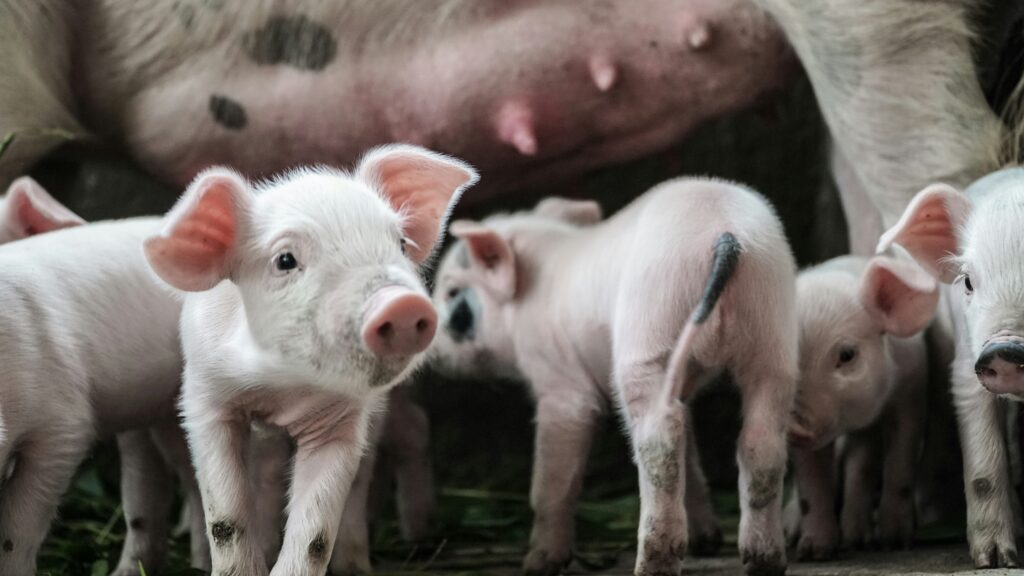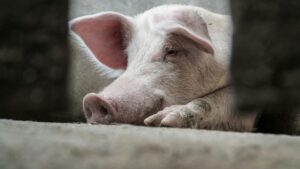Impact of Diseases
Outbreaks of serious diseases affecting pigs in the past have made it very clear to the pig industry that disease prevention is a vital part of farming.
Impact of Diseases

The three main diseases; foot and mouth disease (FMD), “Blue ear” (PRRS), and classical swine fever (hog cholera) at the time cause havoc in the industry. These are all serious because they spread very rapidly in a confined population of pigs, and they do a great deal of damage to the herds that they infect, causing deaths, abortions and still-births on a large scale and without end.
Disease Management
The first outbreaks were fortunately detected in time for strong measures to be taken by the Veterinary Department, including the destruction of many pigs and the clearing out of contact farms. Classical swine fever is very difficult to eradicate. This is always a distressing and expensive exercise, especially for the owners of apparently healthy animals that are taken away for slaughter because they may be carrying the infection. Compensation may be paid for animals that are culled by Government but not for those which have died during the acute period of the disease. As a result, some farmers seem to do well out of the system while others suffer heavy losses.
Ordinary Disease Challenges
Producers who were not affected by the two diseases referred to are nevertheless engaged in a daily battle against the “ordinary” problems that can bankrupt any pig project if badly handled. Raising pigs as a profitable commercial pork producer is not all that easy, and biosecurity risks are a large part of the threat to our success. Luck may have something to do with it, but mostly it is the farmer who has taken the trouble to protect the health of his or her herd that comes off best.

Protecting Pig Herds
It is really a logical process. Think of how your herd is exposed to the things that can bring infection to it. Infective agents are viruses, bacteria and microscopic parasites, none of which are visible but all of which can be carried by people and their clothing, vehicles, other animals, birds, wind and food.
Ten Important Questions
Ask yourself ten important questions about your piggery:
- Do your pigs have freedom to wander outside and mix with other pigs? If so, do the other owners have the same concerns as you do for their pigs’ health?
- Do you have visitors from other places who want to come and see the pigs, especially the babies, which are, after all, so cute?
- Do speculators and butchers come on to the farm to buy or load your pigs when they have been to other pig units?
- Do you feed swill from restaurants, compounds, hospitals etc that is brought to the farm as part of a delivery route involving many properties?
- Do you have a problem with rats, mice, birds in and around the piggery?
- Are your buildings suitably designed and strongly built, to keep your pigs secure and properly housed?
- Do you go to auctions or other places where people and pigs from different areas come together, and do you buy unknown pigs at sales and take them home?
- Do advisers such as vets, nutritionists, reps from firms, feed suppliers, have free access to your pig pens without changing their outer clothes?
- Do you know enough about pig diseases and how to control them with vaccines, injections, in-feed medication? Would you recognize FMD or PRRS or any other serious infection in your herd?
- If you are in an area with small pig units which cannot be isolated from each other, is there an organisation that can get you together for talks on pig problems, sharing local knowledge, looking for safe and economic ways of buying supplies, finding markets, replacing breeding stock, treating everyday diseases such as mange, scours, pneumonia, malnutrition?

Biosecurity Measures
To make a small piggery less vulnerable to disease takes time and money, but not as much as you may think. Here are a few simple steps that will make a huge difference to the biosecurity of your herd, big or small:
- Keep strangers and visitors away from your pigs; have a fence and a gate with a lock that you can control;
- When advisers come to help on the piggery, supply a clean overall and boots which never leave your property;
- Don’t buy other people’s troubles at auctions; get your pigs from one or two reliable breeders;
- Make a structure or an arrangement for the delivery of feed and the loading of pigs that keeps vehicles outside your fence;
- If swill is fed, make sure of its origin and do not regard it as an adequate food for modern pigs;
- Use the assistance and advice that is available to help you farm better; every rand you invest in knowledge will be returned many times over.
Conclusion
What, then, is biosecurity? It is the common sense precautions that any prudent pig producer will take when we think about the health threats facing our pigs. Source: SAPPO

